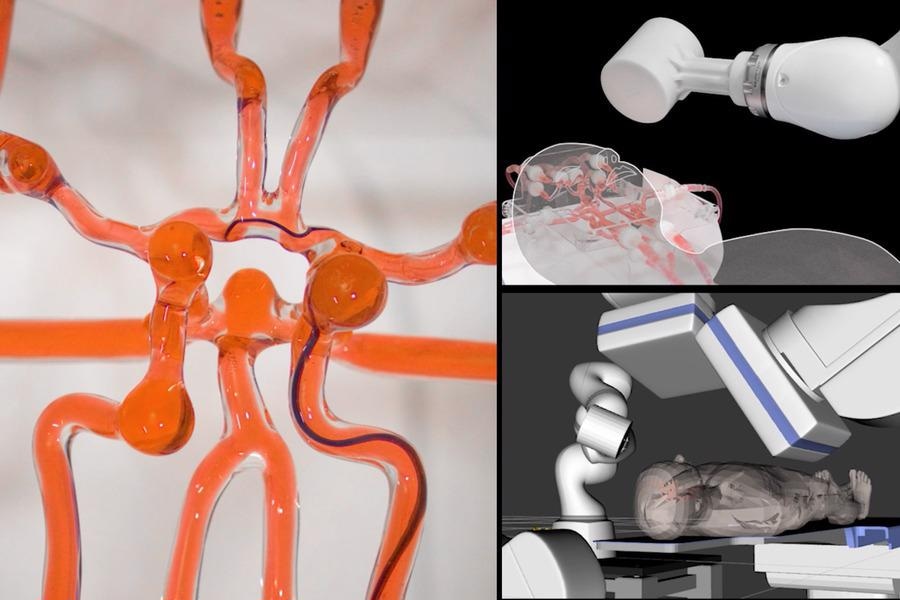Patients that have suffered a stroke could receive critical early treatment in the crucial window shortly after experiencing an attack. This is thanks to a joystick-based system developed by MIT researchers that would give surgeons remote access to patients.
 Image Credit: Chu, J., (2022) Joystick-operated robot could help surgeons treat stroke remotely. [online] MIT News | Massachusetts Institute of Technology. Available at: https://news.mit.edu/2022/robot-stroke-treatment-remote-0413
Image Credit: Chu, J., (2022) Joystick-operated robot could help surgeons treat stroke remotely. [online] MIT News | Massachusetts Institute of Technology. Available at: https://news.mit.edu/2022/robot-stroke-treatment-remote-0413
The joystick controls a modified telerobotic arm that would help treat those that have had a stroke or an aneurysm and potentially offer a better chance of performing life-saving procedures and preserving brain function.
The telerobotic system is controlled through a series of magnets and can offer remote access to endovascular interventions – an emergency surgery that is used to treat blood clot-induced strokes.
Typically, endovascular interventions require the presence of a surgeon to guide a wire towards the blood clot to extract it physically or deliver drugs capable of reducing the size of the clot. However, this procedure can be limited by accessibility as leading neurovascular surgeons are usually based at larger medical facilities in major cities.
Therefore, patients in rural or remote areas may be difficult to reach during the so-called “golden hour,” which is when intervention is crucial.
The Golden Hour
It is critical that those who have suffered a stroke or aneurysm receive urgent medical attention in the golden hour window to minimize the damage the episode may cause to the brain. The joystick-controlled robotic system could offer a lifeline to those living in hard-to-reach locations, granting them access to the best neurovascular surgeons.
The MIT team believes that its telerobotic system could be set up at smaller clinics and hospitals for remote guidance by highly-trained surgeons at major medical institutions. The research was published in full in the journal Science Robotics.
The system incorporates an articulate clinical robotic arm with magnets fastened to its “wrist.” This system allows the robot to be maneuvered using a joystick and camera feed on a live display as the surgeon guides the magnet’s orientation using the joystick to manipulate the arm and direct a thin, soft magnetic wire through the patient’s network of arteries and blood vessels.
Intuitive Robotics
Researchers were able to demonstrate their method in a transparent model known as a “phantom” which replicates the intricate network of arteries and vessels in the brain. What was remarkable about this system is that just an hour’s worth of training gave the surgeons the experience to guide the wire using the joystick and robotic arm. This demonstrates that the system is easy-to-use and intuitive.
We imagine, instead of transporting a patient from a rural area to a large city, they could go to a local hospital where nurses could set up this system. A neurosurgeon at a major medical center could watch live imaging of the patient and use the robot to operate in that golden hour. That’s our future dream.
Xuanhe Zhao, Professor of Mechanical Engineering and Civil and Environmental Engineering, MIT
Intuitive robotic systems are being carefully evaluated as viable technologies to assist surgeons in various situations, including endovascular surgery.
Driven by a motor, the telerobotic arm is able to move forwards, backward, twist, and turn while being piloted by the joystick.
But having a robot twist with the same level of sophistication [as a surgeon] is challenging … Our system is based on a fundamentally different mechanism.
Yoonho Kim, Lead Author, MIT
This latest system builds on previous work that the researchers conducted in 2019, in which when they used a magnetic system to direct a thread through a scale silicone model of the human brain’s blood vessels.
Kim and his team have since upgraded the system by attaching the magnet to the end of a medical-grade telerobotic arm, which can even be manipulated using the joystick knob on a mouse.
When the joystick is tilted, the magnet can tilt in a way in which the magnetic wire is able to follow. The buttons on the mouse are then used to control a series of linear motorized drives, which move forwards and backward, thus guiding the wire to where it needs to be.
The primary purpose of the magnetic guidewire is to get to the target location quickly and safely, so that standard devices like microcatheters can be used to deliver therapeutics … Our system is like a pathfinder.
Yoonho Kim, Lead Author, MIT
One of the exciting possibilities about this technology is that it offers life-saving support to patients in hard-to-reach locations while enhancing the reach of the global health system.
Stroke is one of the main causes of death and long-term, even permanent, disability. Therefore, the MIT team hopes that their robotic system can grant access to those that require urgent “golden hour” treatment.
References and Further Reading
Kim, Y., et al., (2022) Abstract TMP61: Telerobotic Neurovascular Interventions With Magnetic Manipulation. Stroke, [online] 53(Suppl_1). Available at: https://www.science.org/doi/10.1126/scirobotics.abg9907
Chu, J., (2022) Joystick-operated robot could help surgeons treat stroke remotely. [online] MIT News | Massachusetts Institute of Technology. Available at: https://news.mit.edu/2022/robot-stroke-treatment-remote-0413
Disclaimer: The views expressed here are those of the author expressed in their private capacity and do not necessarily represent the views of AZoM.com Limited T/A AZoNetwork the owner and operator of this website. This disclaimer forms part of the Terms and conditions of use of this website.